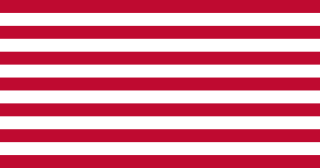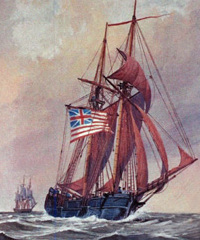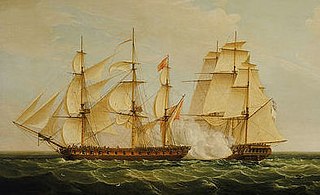The first USS Virginia was a 28-gun sailing frigate of the Continental Navy, a ship with a short and unfortunate career.

The Continental Navy was the navy of the Thirteen Colonies during the American Revolutionary War. Founded on October 13, 1775, the fleet developed into a relatively substantial force throughout the Revolutionary War, owing partially to the substantial efforts of the Continental Navy's patrons within the Continental Congress. These Congressional Patrons included the likes of John Adams, who served as the Chairman of the Naval Committee until 1776, when Commodore Esek Hopkins received instruction from the Continental Congress to assume command of the force.

USS Wasp was originally a merchant schooner named Scorpion, built at Baltimore, and purchased under authority from the Second Continental Congress dated 2 December 1775 by Col. Benjamin Harrison sometime between 2 and 18 December 1775, the first US naval ship to be given that name. She was outfitted in Baltimore from December 1775 to early 1776; and commissioned in December 1775 or January 1776, Capt. William Hallock in command.
The first USS Hornet was a merchant sloop chartered from Captain William Stone in December 1775 to serve under Stone as a unit of Esek Hopkins' Fleet. The voyage would be the first military action for master's mate Joshua Barney. The vessel was damaged while sailing with the fleet and returned to base. Hornet patrolled Delaware Bay until being captured on 27 April 1777 by the Royal Navy. Hornet was taken to and taken to Jamaica, where the ship was found to be leaking and was condemned.
HMS Surprise or Surprize is the name of several ships. These include:

USS Ranger was a sloop-of-war in the Continental Navy in active service in 1777–1780, the first to bear her name. Built at Portsmouth Naval Shipyard on Badger's Island in Kittery, Maine, she is famed for the one-ship raiding campaign by Captain John Paul Jones, during naval operations of the American Revolutionary War. In six months spent primarily in British waters she captured five prizes, staged a single failed attack on the English mainland at Whitehaven, and caused Royal Navy ships to be dispatched against her in the Irish Sea.

USS Raleigh was one of thirteen ships that the Continental Congress authorized for the Continental Navy in 1775. Following her capture in 1778, she served in the Royal Navy as HMS Raleigh. The ship is featured on the flag and seal of New Hampshire.

A South Carolina Navy has been formed twice by the State of South Carolina. The first time was during the American Revolutionary War, in which the state purchased and outfitted armed vessels independent of the Continental Navy. The second time was during the American Civil War, when its navy was also distinct from the Confederate States Navy.
The 16th Massachusetts Regiment, also known as Henry Jackson's Additional Continental Regiment, was a unit of the American Massachusetts Line, raised on January 12, 1777, under Colonel Henry Jackson at Boston, Massachusetts. The regiment would see action at the Battle of Monmouth and the Battle of Rhode Island. The regiment was disbanded on January 1, 1781, at New Windsor, New York.

The 9th Connecticut Regiment was a regiment of the Continental Army during the American Revolutionary War. It was first called Webb's Additional Continental Regiment before being added to the Connecticut Line in 1780. It saw action at Setauket in 1777, Rhode Island in 1778, and Springfield, New Jersey, in 1780, and was generally active in the defense of Connecticut, southern New York, and northern New Jersey. It was merged into the reorganized 2nd Connecticut Regiment in January 1781.
Enterprise, was the second American ship to bear the name. She was a successful privateer before she was purchased for the Continental Navy in 1776. Commanded by Captain James Campbell, the schooner Enterprise operated principally in Chesapeake Bay. She convoyed transports, carried out reconnaissance, and guarded the shores against foraging raids by the British. Only meager records of her service have been found; they indicate that she was apparently returned to the Maryland Council of Safety in 1777.

The Massachusetts Naval Militia, was a naval militia active during the American Revolutionary War. It was founded December 29, 1775, to defend the interests of Massachusetts during the war.

USS Fly was an eight-gun sloop in the Continental Navy. She was part of a squadron that raided the port of Nassau and engaged the 20-gun HMS Glasgow.
USS Independence was a sloop in the Continental Navy. Acting as a dispatch boat, she was sent to France on a diplomatic mission – carrying important dispatches. While there, John Paul Jones embarked on her, and she received additional salutes to the American Republic from the French.
Seventeen ships of the Royal Navy have borne the name HMS Dispatch, or the variant HMS Despatch:

The Rhode Island State Navy was the first colonial or state navy established after the American Revolutionary War began in April 1775 with the Battles of Lexington and Concord. On the following June 15, the General Assembly authorized the acquisition of two ships for the purpose of defending the colony's trade. The state's ships were generally used for defensive operations within Narragansett Bay, although some prizes were taken. The state was also one of the first to authorize privateering.

HMS Phoenix was a 44-gun fifth-rate ship of the Royal Navy. She was launched in 1759 and sunk in 1780 and saw service during the American War of Independence.
HMS Diligent was a brig the Royal Navy purchased in 1777. The Continental Navy captured her in May 1779 and took her into service as the USS Diligent. She then participated in the disastrous Penobscot Expedition where her crew had to scuttle her in August to prevent her capture.

HMS Pearl was a fifth-rate, 32-gun British Royal Navy frigate of the Niger-class. Launched at Chatham Dockyard in 1762, she served in British North America until January 1773, when she sailed to England for repairs. Returning to North America in March 1776, to fight in the American Revolutionary War, Pearl escorted the transports which landed troops in Kip's Bay that September. Much of the following year was spent on the Delaware River where she took part in the Battle of Red Bank in October. Towards the end of 1777, Pearl joined Vice-Admiral Richard Howe's fleet in Narragansett Bay and was still there when the French fleet arrived and began an attack on British positions. Both fleets were forced to retire due to bad weather and the action was inconclusive. Pearl was then despatched to keep an eye on the French fleet, which had been driven into Boston.

The first USS Mosquito was believed to have been purchased at Philadelphia late in 1775 for the new Continental Navy. She patrolled the Delaware River until destroyed during the British capture of Philadelphia led by the Howe brothers and completed by them in October 1777. The Dictionary of American Naval Fighting Ships (DANFS) has identified this ship as a sloop, yet records from the period which are believed to refer to the ship have consistently identified her as being a schooner. These records also provide a bit more detail of her fate, indicating she was burned after capture in July 1777 during Royal Navy operations along the Delaware River.









